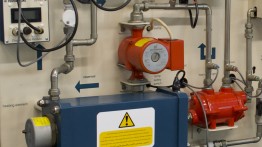Mechatronics Laboratory
Mechatronics combines mechanical engineering and electronic control using a systems perspective for the design of products and processes. With the advent of inexpensive microprocessors, the benefits of a mechatronics design philosophy span application areas such as product design, manufacturing, robotics, instrumentation, and process and device control. The Mechatronics Laboratory includes 960 square feet of designated space for both hands-on learning and research purposes with an emphasis on design and application of mechatronics and control systems theory. The Mechatronics Laboratory is used in the Process Control Laboratory Course (ME352), Mechatronics (ME353), Autonomous Mobile Robots (ME412), and Experimentation (ME360) courses to supplement technical concepts with practical applications.
To experiment with problems and applications associated with industrial process control, students in the Process Control Laboratory (ME352) utilize process control (PROCON) test rigs, which include: (1) two liquid level-flow process rigs, (2) two heat exchanger and radiator/fan temperature control rigs, and (3) a pressure control rig consisting of a pipeline on which a pneumatic control valve, orifice block, flow meter and pressure tappings are mounted. All PROCON test rigs utilize ABB industrial controllers that interface with computer workstations. These experimental workstations mirror the types of systems engineers encounter in industry, such as heating, ventilation, and air-conditioning; petrochemical; and pharmaceutical plants. As part of a NSF award titled “Building Sustainability into Control Systems Courses” (Grant No. DUE #1044830; $107,884), these PROCON test rigs were upgraded with new modern controllers, configurable laboratory software interface and a redesigned laboratory manual. These PROCON experiments are supplemented with building mechanical room tours and online learning materials to expose mechanical engineering students to real-world applications related to building control systems. Student researchers also have read-only access to the Building Management System for building control and energy efficiency research projects.
The Mechatronics Laboratory includes several computer workstations for conducting feedback control experiments and mechatronics projects. Eight workstations are equipped with Quanser QUBE DC Motor rigs also used in ME352.
Each workstation in the Mechatronics Laboratory is further outfitted with electronics hardware, including power supplies, oscilloscopes, function generators, breadboards, and circuit programmers, used for signal processing and prototyping. These workstations are also used by students in the Mechatronics (ME353) and Autonomous Mobile Robots (ME412) courses, in which students build autonomous mobile robots designed to perform tasks or to compete with each other. The laboratory is further equipped with LabVIEW software and National Instruments data acquisition devices and laptops for remote data acquisition. To demonstrate digital signal processing concepts, seven National Instruments Educational Laboratory Virtual Instrumentation Suite (ELVIS) are used in Advanced Vibration (ME401) and available to students for breadboarding projects. These data acquisition devices are often lent to students throughout the engineering school for taking data for various undergraduate and graduate student research projects. The laboratory also houses equipment for building energy auditing and air quality monitoring and to support the hands-on workshops in the interdisciplinary Environmental Technology courses (EID233/ARCH134A and EID234/ARCH134B), which was purchased with support of a School of Engineering Educational Innovation Grant and support from the IDC Foundation’s Innovation Initiative This process is maintained via an Excel spreadsheet which lists the equipment and to whom it is checked out.





